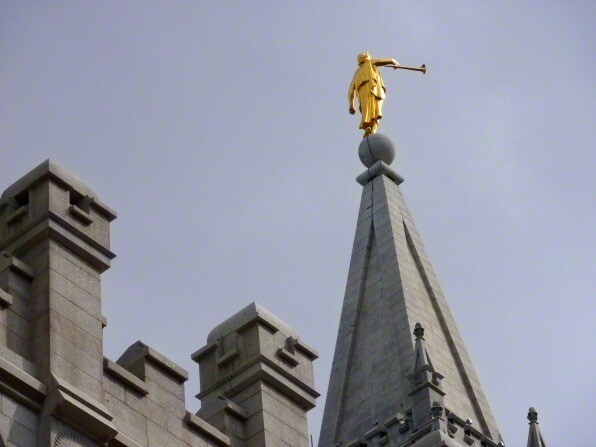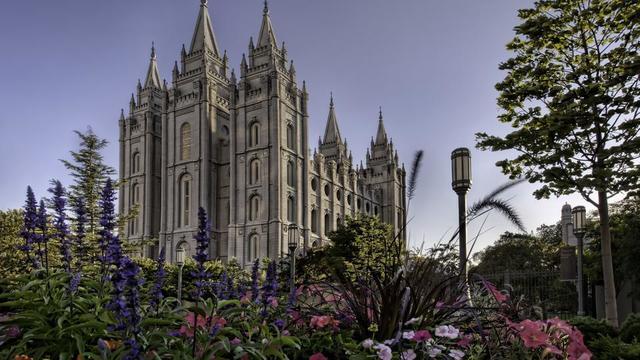The Salt Lake Temple is an iconic building for members of the Church. The history behind the temple and the sacrifices early Saints made to complete it are inspiring and touching.
Many of us have heard how it took 40 years to complete, but there’s so much more to the story of how the temple came to be what it is today. The rich history and little-known facts about the Salt Lake Temple give us even more to love and appreciate about this house of the Lord.
► You'll also like: Church Releases Renderings of What the Salt Lake Temple Will Look Like After Renovations
1. “This is the place” (part two).
When the Latter-day Saint pioneers arrived in the Salt Lake Valley, Brigham Young famously proclaimed, “This is the place.”
What a lot of people don’t know is that he said something similar when he decided where the temple would be built. Just days after arriving in the Salt Lake Valley, Brigham Young, Wilford Woodruff, and some of their associates were walking in the valley when Brigham Young “stopped, drove his cane into the earth, and declared, ‘Here we will build the temple of our God.’”
► You'll also like: The myth about Brigham Young's ‘This is the place’ quote
2. The architect knew he would design temples from his patriarchal blessing.
Truman O. Angell was the official architect for the Church and did great work in designing buildings. He helped build the Kirtland and Nauvoo temples, then moved to the Salt Lake Valley, arriving in 1847.
In 1850, Brigham Young called Angell as the official Church architect and sent him to Europe to train and tour the buildings there. He designed the Salt Lake Temple, the Lion House, the Beehive House, the Utah Territorial Statehouse, and the St. George Utah Temple, and his assistants worked on the Logan and Manti temples. Unfortunately, he passed away six years before the Salt Lake Temple was completed.
► You'll also like: What the Salt Lake Temple might have looked like
According to ChurchofJesusChrist.org, “Angell, a skillful carpenter and joiner, was told in his patriarchal blessing that he would become a builder of temples and cities.” He truly magnified his life calling and we get to experience the beautiful temples he designed as a result.
3. The foundation had to be built twice.
After the Saints laid the original foundation for the temple, they received news that the US Army was coming to Utah. They quickly covered the construction site with dirt to protect it, but when the army left and they uncovered it, Brigham Young noticed the cornerstones were cracked. He decided the foundation would be completely replaced with granite 16-foot-thick footings. The building, rebuilding, and construction of the foundation took 14 years, and the builders didn’t reach ground-level until 1867.
Brigham Young was focused on quality, even though he knew it would take more time. “I am willing to wait a few years for it,” he said. “I want to see the temple built in a manner that will endure through the Millennium.”
A BYU Studies article, "The Salt Lake Temple Infrastructure" by Paul C. Richards, says, “As George Q. Cannon wrote, the temple was ‘built to stand, without a crack or quiver, for a thousand years.’” The sturdy foundation of the temple has surely stood the test of time. In addition to the 16-foot-thick footings, the walls toward the base of the temple are nine feet thick and the walls toward the top of the building are six feet thick.
4. The Church provided a camp for workers.
Because the temple builders were working six days per week for 10 hours each day, the Church provided them a place to rest and recuperate from their hard labor. The workers would often travel to retrieve the materials and stones to build the temple.
Newsroom writes, “Each stone weighed between 2,000 and 6,000 pounds. The stones were hauled by wagon from the quarry to the temple site along a road that was riddled with hills and gullies, streams and sandpits. Three or four yoke of oxen and full-time teamsters were required to make the four-day round-trip journey from the quarry to the temple block.”

5. Women were a huge help in building the temple.
We often hear stories of the men who dedicated their lives to building the temple, but there were many women who also made sacrifices.
One teenager named Margaret Shelton Kinsey showed her dedication to the cause despite her lack of money to donate. “She collected patches of wool that sheep left behind on twigs and barbed-wire fences, formed the wool into small balls and then sold the wool for money that she contributed to the building of the temple,” Newsroom reported. “Years later she would tell her grandchildren that in her own way, she had helped pay for the temple.”
► You'll also like: 40 things you didn't know about Temple Square
Other women worked in the home to support their families while their husbands were away working on the temple. Although very few of the original temple builders lived to see the finished product, it was obvious that everyone cared deeply about the project and knew how important it was.
6. The outside of the temple was built first.
As you can tell in this photo, people could see straight through the temple when it was being built. The outside was built first, so the interior was left as a large empty space.

7. There’s more to the Angel Moroni than we can see.
One of the iconic features of a Latter-day Saint temple is the golden angel Moroni standing tall on the roof. We might not think much about the shining statue when we approach the temple doors or see a photo, but it actually takes a lot to keep it standing.
The Salt Lake Temple angel Moroni is 12-feet, 5-inches tall with a steel rod going 27 feet down into the building. There is also a 4,000-pound counterweight at the bottom, ensuring that the angel will withstand extreme weather conditions.

► You'll also like:40 Things You Didn’t Know About Temple Square
8. Someone snuck inside the dedicated temple and took photos of everything.
There was a huge scandal in 1911 when a man named Gisbert Bossard snuck inside the temple and photographed everything in hopes of selling the photos for a large profit.
Bossard made friends with one of the temple gardeners who had a set of keys, and the gardener gave Bossard access to the temple. “He confided to his father that upon entering the temple grounds, ‘he hid the cameras under his coat and that some of the pictures were taken during the daytime and others at night by flashlight,’” according to an essay.
When Bossard’s identity was made known and the only thing he could be charged with was trespassing, the Church decided to take a unique approach. James E. Talmage suggested to the First Presidency that they should publish a booklet about the temple with interior photos. The booklet was created and distributed for free, stealing Bossard’s thunder and ruining his plans.
► You'll also like: The unexpected way the Church responded to a blackmail attempt
9. The temple was bombed in 1962.
Residents near Temple Square were awakened in the middle of the night on November 14, 1962, when they heard a loud sound. Some thought it was an earthquake because it shook their homes, but it was, in fact, an explosion.
According to Deseret Digest, "One of the doors on the temple's east front exhibited a five-inch hole where a doorknob had once sat. The windows on that door, and several set in the granite walls above and around the door had all been shattered; a total of 11 windows were broken, including some in the interior."
There were other damages inside the temple, including light fixtures and wooden splinters, and it was reported that a doorknob punctured a hole in the wall. It was concluded that the damage was probably a result of a plastic explosive.
10. The temple exterior is very symbolic.
There are so many details on the temple exterior that are symbolic of different things in the Church. But one example that might be lesser-known is that the circular and rectangular windows that wrap around the building are symbolic of a person’s journey from imperfection to perfection, mortal life to eternal life.
Temple Square Blog writes, “Individually the circle has been a historic symbol for perfection as well as unending or infinite, so it’s only fitting that in the temple’s design the circle represents eternal life while the square is meant to symbolize the earth and life on earth.”

We are so blessed to have temples all around the world today, and the early Saints who dedicated their lives to building the Salt Lake Temple are incredible reminders of how important temple work really is.

